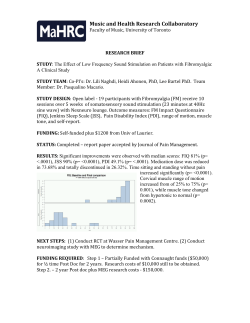
SD FAQ - UO Blogs - University of Oregon
Women’s Self-‐Defense Frequently-‐Asked Questions Jocelyn A. Hollander, Ph.D., University of Oregon September 15, 2014 What is women’s self-‐defense? • Perhaps the most common stereotype of women’s self-‐defense is a woman – probably young, white, and fit – karate-‐kicking a stranger in a dark alley or parking garage. However, self-‐defense is far more than just physical fighting, and it is accessible to all women, regardless of their age, race, level of fitness, or physical ability. It also addresses far more than just assaults by strangers. • There are many types of self-‐defense training. The kind that has been most frequently studied by researchers is empowerment self-‐defense. These classes: o focus on the full range of violence against women, especially acquaintance assaults, which are the most common type of sexual assault. o include awareness and verbal self-‐defense strategies as well as physical techniques. These skills empower women to stop assaults in their early stages, before they escalate to physical danger. o teach effective physical tactics that build on the strengths of women’s bodies and require minutes or hours rather than years to master. o offer a toolbox of strategies for avoiding and interrupting violence, and, rather than teaching a single “best” way to respond to violence, empower women to choose the options that are appropriate for their own situations. o address the social conditions that facilitate sexual assault and the psychological barriers to self-‐defense that women face as a result of gender socialization. Does self-‐defense prevent violence? This is really two questions: • • First, can women’s resistance stop sexual assault? The answer is a resounding yes. There is a large and nearly unanimous body of research that demonstrates that women frequently resist violence, and that their resistance is often successful. This research, of course, includes many women without self-‐defense training. Second, does self-‐defense training decrease women’s risk of assault? There is a smaller but rapidly expanding research literature that suggests that women who learn self-‐ defense are significantly less likely to experience assault. For example, Hollander’s research (2014) found that women who enrolled in a holistic, empowerment-‐based self-‐ defense class were 2.5 times less likely to be assaulted over the following year, compared with similar women who did not take such a class. No women with self-‐ defense training, but nearly 3% of women without training, reported being raped during the follow-‐up period. Does self-‐defense increase a woman’s risk of injury? • No. There is an association between resistance and injury, in that women who resist a sexual assault are also more likely to be injured. But research that looks at the sequence of events has found that in general, the injury precedes the resistance. In other words, women resist because they are being injured, rather than being injured because they resist. On average, resistance does not increase the risk of injury. Shouldn’t we be putting all our resources into prevention strategies focused on perpetrators? • No. Violence against women is a complex social problem. Ultimately, large-‐scale social changes will be needed before violence against women can be stopped. However, this kind of social change is slow – and so far, our efforts have not been very successful. If we focus only on perpetrator-‐focused, “primary” prevention strategies, we are condemning millions of women to suffering rape and sexual assault. While we wait for these efforts to work, empowerment-‐based self-‐defense training can provide an immediate, and effective, antidote for sexual violence. • There has been little research on the effectiveness of prevention strategies focused on potential perpetrators. Most strategies that have been rigorously evaluated have been found to be ineffective at preventing violence. • Preventing sexual violence will require a comprehensive range of efforts. Some efforts should be long-‐term (e.g., cultural climate assessment and change), others should be medium-‐term (e.g., bystander intervention training), and some should be short-‐term (e.g., self-‐defense training). We do not have to choose only one approach; a complex social problem requires that we address it on multiple fronts and in multiple ways. Is self-‐defense training cost-‐effective? • Yes. Sexual assault is very expensive, in terms of post-‐assault medical service, legal services, and human suffering. Self-‐defense training, in contrast, is quite inexpensive. A recent Nairobi-‐based study found that comprehensive self-‐defense training cost US$1.75 for every assault prevented, compared with an average of US$86 for post-‐ assault hospital services. Given the higher cost of medical services, it is likely that the savings would be even greater in the United States. Is self-‐defense victim blaming? • No. Empowerment-‐based self-‐defense classes explicitly attribute responsibility for assault to perpetrators, not victims. Just because a woman is capable of defending herself does not mean that she is responsible for doing so. • Although self-‐defense training is frequently lumped in with other kinds of risk reduction advice (e.g., staying out of public spaces, traveling with a buddy, wearing modest clothing, or avoiding alcohol), it differs in important ways. Staying home, relying on others for protection, and limiting one’s clothing or alcohol consumption all constrain women’s lives. Self-‐defense training, in contrast, expands women’s range of action, empowering them to make their own choices about where they go and what they do. • Some people have worried that women who learn self-‐defense may blame themselves if they are later unable to prevent an attack. However, research has found that women with self-‐defense training who experience a subsequent assault blame themselves no more – or even less – than women without self-‐defense training. Moreover, women who are raped but physically resist are actually less likely than other women to blame themselves for their assault. What else should I know about self-‐defense training? • Learning self-‐defense empowers women in ways that go far beyond preventing assault. Self-‐defense training decreases women’s fear and anxiety and increases their confidence, their sense of self-‐efficacy, and their self-‐esteem. Learning self-‐defense helps women feel stronger and more confident in their bodies. Women report more comfortable interactions with strangers, acquaintances, and intimates, both in situations that seem dangerous and those that do not. Further Resources and Research on Women’s Resistance and Self-‐Defense What is women’s self-‐defense? Thompson, Martha E. 2014. “Empowering Self-‐Defense Training.” Violence Against Women 20(3):351–359. Does self-‐defense prevent violence? Gidycz, Christine A, and Christina M. Dardis. 2014. “Feminist Self-‐Defense and Resistance Training for College Students A Critical Review and Recommendations for the Future.” Trauma, Violence, & Abuse 1524838014521026. Hollander, Jocelyn A. 2014. “Does Self-‐Defense Training Prevent Sexual Violence Against Women?” Violence Against Women 20(3):252–269. Orchowski, Lindsay M., Christine A Gidycz, and Holly Raffle. 2008. “Evaluation of a Sexual Assault Risk Reduction and Self-‐Defense Program: A Prospective Analysis of a Revised Protocol.” Psychology of Women Quarterly 32:204–218. Sarnquist, Clea et al. 2014. “Rape Prevention Through Empowerment of Adolescent Girls.” Pediatrics peds.2013– 3414. Senn, Charlene Y., Stephanie S. Gee, and Jennifer Thake. 2011. “Emancipatory Sexuality Education and Sexual Assault Resistance: Does the Former Enhance the Latter?” Psychology of Women Quarterly 35(1):72–91. Sinclair, Jake et al. 2013. “A Self-‐Defense Program Reduces the Incidence of Sexual Assault in Kenyan Adolescent Girls.” Journal of Adolescent Health 53(3):374–380. Tark, Jongyeon, and Gary Kleck. 2014. “Resisting Rape The Effects of Victim Self-‐Protection on Rape Completion and Injury.” Violence Against Women 20(3):270–292. Ullman, Sarah E. 2007. “A 10-‐Year Update of ‘Review and Critique of Empirical Studies of Rape Avoidance’.” Criminal Justice and Behavior 34(3):1–19. Ullman, Sarah E. 1997. “Review and Critique of Empirical Studies of Rape Avoidance.” Criminal Justice and Behavior 24:177–204. Brecklin, Leanne R., and Sarah E. Ullman. 2005. “Self-‐Defense or Assertiveness Training and Women’s Responses to Sexual Attacks.” Journal of Interpersonal Violence 20(6):738–762. Does self-‐defense increase a woman’s risk of injury? Ullman, Sarah E., and R. A. Knight. 1992. “Fighting Back: Women’s Resistance to Rape.” Journal of Interpersonal Violence 7:31–43. Ullman, Sarah E, and Raymond A Knight. 1993. “THE EFFICACY OF WOMEN’S RESISTANCE STRATEGIES IN RAPE SITUATIONS.” Psychology of Women Quarterly 17(1):23–38. Aren’t prevention strategies focused on perpetrators a better idea? Gidycz, Christine A et al. n.d. “Concurrent administration of sexual assault prevention and risk reduction programming: Outcomes for women.” Violence Against Women. In press. Gidycz, Christine A, and Christina M. Dardis. 2014. “Feminist Self-‐Defense and Resistance Training for College Students A Critical Review and Recommendations for the Future.” Trauma, Violence, & Abuse 1524838014521026. Orchowski, Lindsay M, Christine A Gidycz, and M J Murphy. 2010. “Preventing campus-‐based sexual violence.” Pp. 415–447 in The Prevention of Sexual VIolence: A Practitioner’s Sourcebook, edited by K L Kaufman. Holyoke, MA: NEARI Press. Breitenbecher, K. H., and M. Scarce. 1999. “A Longitudinal Evaluation of the Effectiveness of a Sexual Assault Education Program.” Journal of Interpersonal Violence 14(5):459–478. Hollander, Jocelyn A. 2014. “Does Self-‐Defense Training Prevent Sexual Violence Against Women?” Violence Against Women 20(3):252–269. Sarnquist, Clea et al. 2014. “Rape Prevention Through Empowerment of Adolescent Girls.” Pediatrics peds.2013– 3414. Sinclair, Jake et al. 2013. “A Self-‐Defense Program Reduces the Incidence of Sexual Assault in Kenyan Adolescent Girls.” Journal of Adolescent Health 53(3):374–380. Is self-‐defense training cost-‐effective? Sarnquist, Clea et al. 2014. “Rape Prevention Through Empowerment of Adolescent Girls.” Pediatrics peds.2013– 3414. Is self-‐defense victim blaming? Bart, Pauline B., and Patricia H. O’Brien. 1985. Stopping Rape: Successful Survival Strategies. Elmsford, NY: Pergamon. Cermele, J. A. 2004. “Teaching Resistance to Teach Resistance: The Use of Self-‐Defense in Teaching Undergraduates about Gender Violence.” Feminist Teacher 15(1):1–15. Gidycz, Christine A et al. n.d. “Concurrent administration of sexual assault prevention and risk reduction programming: Outcomes for women.” Violence Against Women. In press. Orchowski, Lindsay M., Christine A Gidycz, and Holly Raffle. 2008. “Evaluation of a Sexual Assault Risk Reduction and Self-‐Defense Program: A Prospective Analysis of a Revised Protocol.” Psychology of Women Quarterly 32:204–218. Rozee, Patricia D, and Mary P Koss. 2001. “Rape: A Century of Resistance.” Psychology of Women Quarterly 25(4):295–311. What else should I know about self-‐defense training? Brecklin, Leanne R. 2008. “Evaluation Outcomes of Self-‐Defense Training for Women: A Review.” Aggression and Violent Behavior 13:60–76. Hollander, Jocelyn A. 2004. “‘I Can Take Care of Myself’: The Impact of Self-‐Defense Training on Women’s Lives.” Violence Against Women 10(3):205–235. McCaughey, Martha. 1997. Real Knockouts: The Physical Feminism of Women’s Self-‐Defense. New York: New York University Press. Ozer, Elizabeth M., and Albert Bandura. 1990. “Mechanisms Governing Empowerment Effects: A Self-‐Efficacy Analysis.” Journal of Personality and Social Psychology 58(3):472–486. Weitlauf, Julie C., D. Cervone, R. E. Smith, and P. M. Wright. 2001. “Assessing Generalization in Perceived Self-‐ Efficacy: Multidomain and Global Assessments of the Effects of Self-‐Defense Training for Women.” Personality & Social Psychology Bulletin 27(12):1683–1691. Weitlauf, Julie C., Ronald E. Smith, and Daniel Cervone. 2000. “Generalization Effects of Coping Skills Training: Influence of Self-‐Defense Training on Women’s Efficacy Beliefs, Assertiveness, and Aggression.” Journal of Applied Psychology 85(4):625–633.
© Copyright 2025









